Professional Nursing II: Code of Conduct and Interaction Evaluation
VerifiedAdded on 2023/01/19
|12
|3454
|56
Report
AI Summary
This report provides a reflective analysis of a nursing interaction between a Registered Nurse (RN) and a patient, Mrs. Wong, in a matured care office. The interaction focused on educating Mrs. Wong about the use of incontinence products. The report assesses the RN's actions against the Nursing Council of New Zealand's (NCNZ) Code of Conduct, highlighting principles such as respecting patient dignity, cultural needs, and promoting well-being. The analysis includes an evaluation of the RN's communication, informed consent, and consideration of Mrs. Wong's cultural background and language barriers. The report emphasizes the importance of ethical considerations, cultural sensitivity, and patient-centered care in professional nursing practice, demonstrating how the RN adhered to the Code of Conduct by involving family, respecting patient choices, and ensuring a safe and private environment. The report also touches on the legal obligations of nurses, highlighting their responsibilities in providing accurate information and advocating for vulnerable patients.
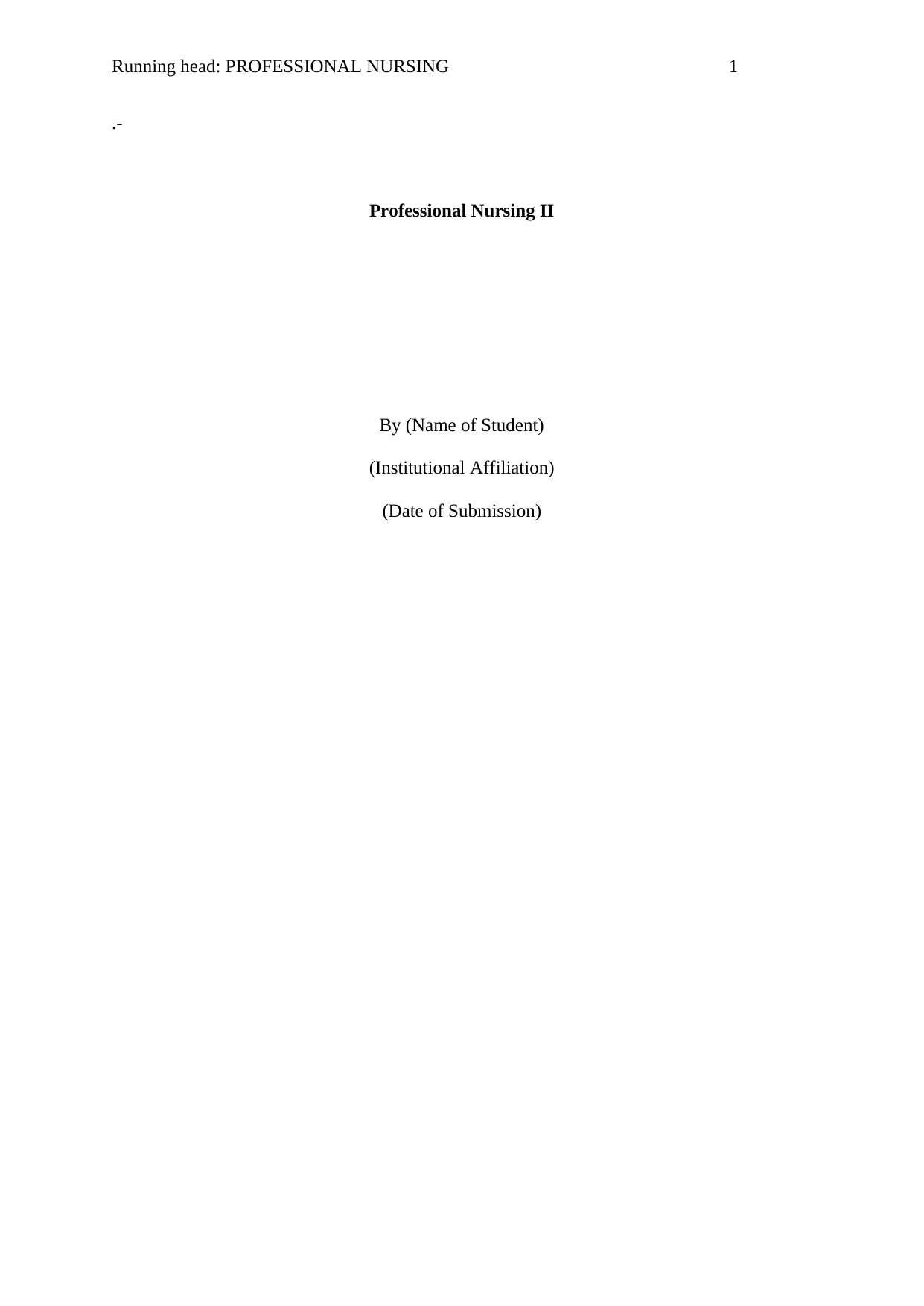
Running head: PROFESSIONAL NURSING 1
.-
Professional Nursing II
By (Name of Student)
(Institutional Affiliation)
(Date of Submission)
.-
Professional Nursing II
By (Name of Student)
(Institutional Affiliation)
(Date of Submission)
Paraphrase This Document
Need a fresh take? Get an instant paraphrase of this document with our AI Paraphraser
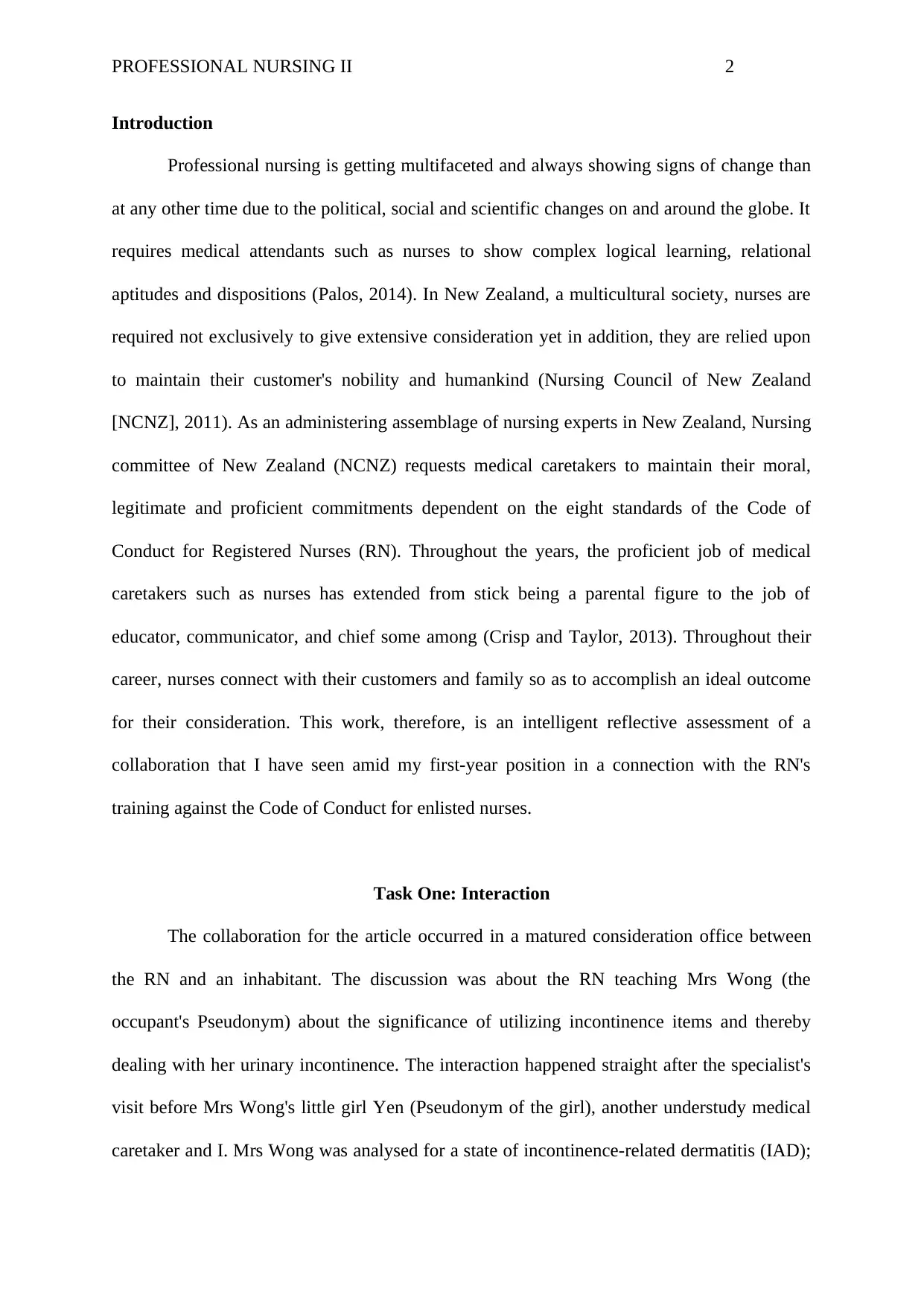
PROFESSIONAL NURSING II 2
Introduction
Professional nursing is getting multifaceted and always showing signs of change than
at any other time due to the political, social and scientific changes on and around the globe. It
requires medical attendants such as nurses to show complex logical learning, relational
aptitudes and dispositions (Palos, 2014). In New Zealand, a multicultural society, nurses are
required not exclusively to give extensive consideration yet in addition, they are relied upon
to maintain their customer's nobility and humankind (Nursing Council of New Zealand
[NCNZ], 2011). As an administering assemblage of nursing experts in New Zealand, Nursing
committee of New Zealand (NCNZ) requests medical caretakers to maintain their moral,
legitimate and proficient commitments dependent on the eight standards of the Code of
Conduct for Registered Nurses (RN). Throughout the years, the proficient job of medical
caretakers such as nurses has extended from stick being a parental figure to the job of
educator, communicator, and chief some among (Crisp and Taylor, 2013). Throughout their
career, nurses connect with their customers and family so as to accomplish an ideal outcome
for their consideration. This work, therefore, is an intelligent reflective assessment of a
collaboration that I have seen amid my first-year position in a connection with the RN's
training against the Code of Conduct for enlisted nurses.
Task One: Interaction
The collaboration for the article occurred in a matured consideration office between
the RN and an inhabitant. The discussion was about the RN teaching Mrs Wong (the
occupant's Pseudonym) about the significance of utilizing incontinence items and thereby
dealing with her urinary incontinence. The interaction happened straight after the specialist's
visit before Mrs Wong's little girl Yen (Pseudonym of the girl), another understudy medical
caretaker and I. Mrs Wong was analysed for a state of incontinence-related dermatitis (IAD);
Introduction
Professional nursing is getting multifaceted and always showing signs of change than
at any other time due to the political, social and scientific changes on and around the globe. It
requires medical attendants such as nurses to show complex logical learning, relational
aptitudes and dispositions (Palos, 2014). In New Zealand, a multicultural society, nurses are
required not exclusively to give extensive consideration yet in addition, they are relied upon
to maintain their customer's nobility and humankind (Nursing Council of New Zealand
[NCNZ], 2011). As an administering assemblage of nursing experts in New Zealand, Nursing
committee of New Zealand (NCNZ) requests medical caretakers to maintain their moral,
legitimate and proficient commitments dependent on the eight standards of the Code of
Conduct for Registered Nurses (RN). Throughout the years, the proficient job of medical
caretakers such as nurses has extended from stick being a parental figure to the job of
educator, communicator, and chief some among (Crisp and Taylor, 2013). Throughout their
career, nurses connect with their customers and family so as to accomplish an ideal outcome
for their consideration. This work, therefore, is an intelligent reflective assessment of a
collaboration that I have seen amid my first-year position in a connection with the RN's
training against the Code of Conduct for enlisted nurses.
Task One: Interaction
The collaboration for the article occurred in a matured consideration office between
the RN and an inhabitant. The discussion was about the RN teaching Mrs Wong (the
occupant's Pseudonym) about the significance of utilizing incontinence items and thereby
dealing with her urinary incontinence. The interaction happened straight after the specialist's
visit before Mrs Wong's little girl Yen (Pseudonym of the girl), another understudy medical
caretaker and I. Mrs Wong was analysed for a state of incontinence-related dermatitis (IAD);
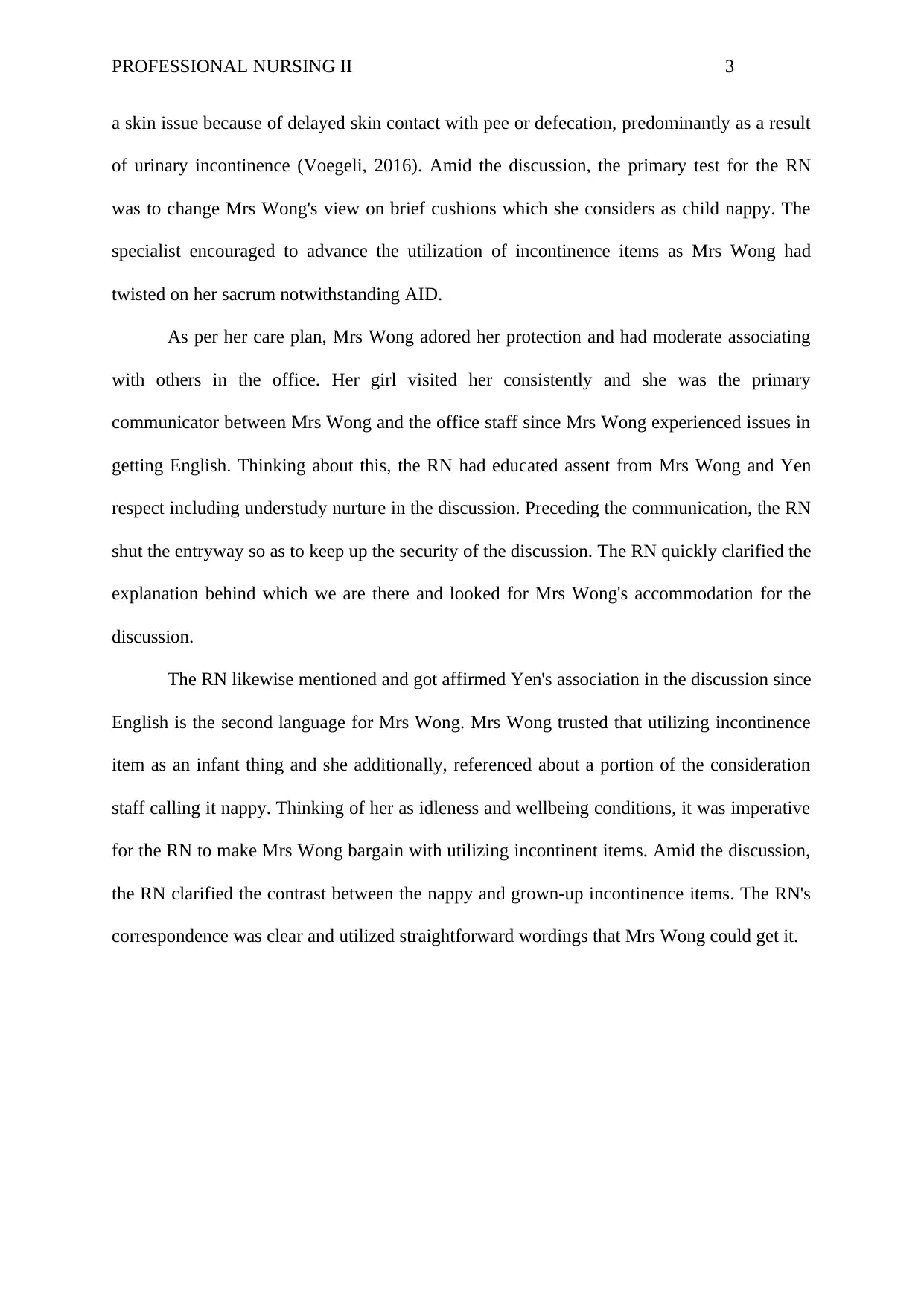
PROFESSIONAL NURSING II 3
a skin issue because of delayed skin contact with pee or defecation, predominantly as a result
of urinary incontinence (Voegeli, 2016). Amid the discussion, the primary test for the RN
was to change Mrs Wong's view on brief cushions which she considers as child nappy. The
specialist encouraged to advance the utilization of incontinence items as Mrs Wong had
twisted on her sacrum notwithstanding AID.
As per her care plan, Mrs Wong adored her protection and had moderate associating
with others in the office. Her girl visited her consistently and she was the primary
communicator between Mrs Wong and the office staff since Mrs Wong experienced issues in
getting English. Thinking about this, the RN had educated assent from Mrs Wong and Yen
respect including understudy nurture in the discussion. Preceding the communication, the RN
shut the entryway so as to keep up the security of the discussion. The RN quickly clarified the
explanation behind which we are there and looked for Mrs Wong's accommodation for the
discussion.
The RN likewise mentioned and got affirmed Yen's association in the discussion since
English is the second language for Mrs Wong. Mrs Wong trusted that utilizing incontinence
item as an infant thing and she additionally, referenced about a portion of the consideration
staff calling it nappy. Thinking of her as idleness and wellbeing conditions, it was imperative
for the RN to make Mrs Wong bargain with utilizing incontinent items. Amid the discussion,
the RN clarified the contrast between the nappy and grown-up incontinence items. The RN's
correspondence was clear and utilized straightforward wordings that Mrs Wong could get it.
a skin issue because of delayed skin contact with pee or defecation, predominantly as a result
of urinary incontinence (Voegeli, 2016). Amid the discussion, the primary test for the RN
was to change Mrs Wong's view on brief cushions which she considers as child nappy. The
specialist encouraged to advance the utilization of incontinence items as Mrs Wong had
twisted on her sacrum notwithstanding AID.
As per her care plan, Mrs Wong adored her protection and had moderate associating
with others in the office. Her girl visited her consistently and she was the primary
communicator between Mrs Wong and the office staff since Mrs Wong experienced issues in
getting English. Thinking about this, the RN had educated assent from Mrs Wong and Yen
respect including understudy nurture in the discussion. Preceding the communication, the RN
shut the entryway so as to keep up the security of the discussion. The RN quickly clarified the
explanation behind which we are there and looked for Mrs Wong's accommodation for the
discussion.
The RN likewise mentioned and got affirmed Yen's association in the discussion since
English is the second language for Mrs Wong. Mrs Wong trusted that utilizing incontinence
item as an infant thing and she additionally, referenced about a portion of the consideration
staff calling it nappy. Thinking of her as idleness and wellbeing conditions, it was imperative
for the RN to make Mrs Wong bargain with utilizing incontinent items. Amid the discussion,
the RN clarified the contrast between the nappy and grown-up incontinence items. The RN's
correspondence was clear and utilized straightforward wordings that Mrs Wong could get it.
⊘ This is a preview!⊘
Do you want full access?
Subscribe today to unlock all pages.

Trusted by 1+ million students worldwide
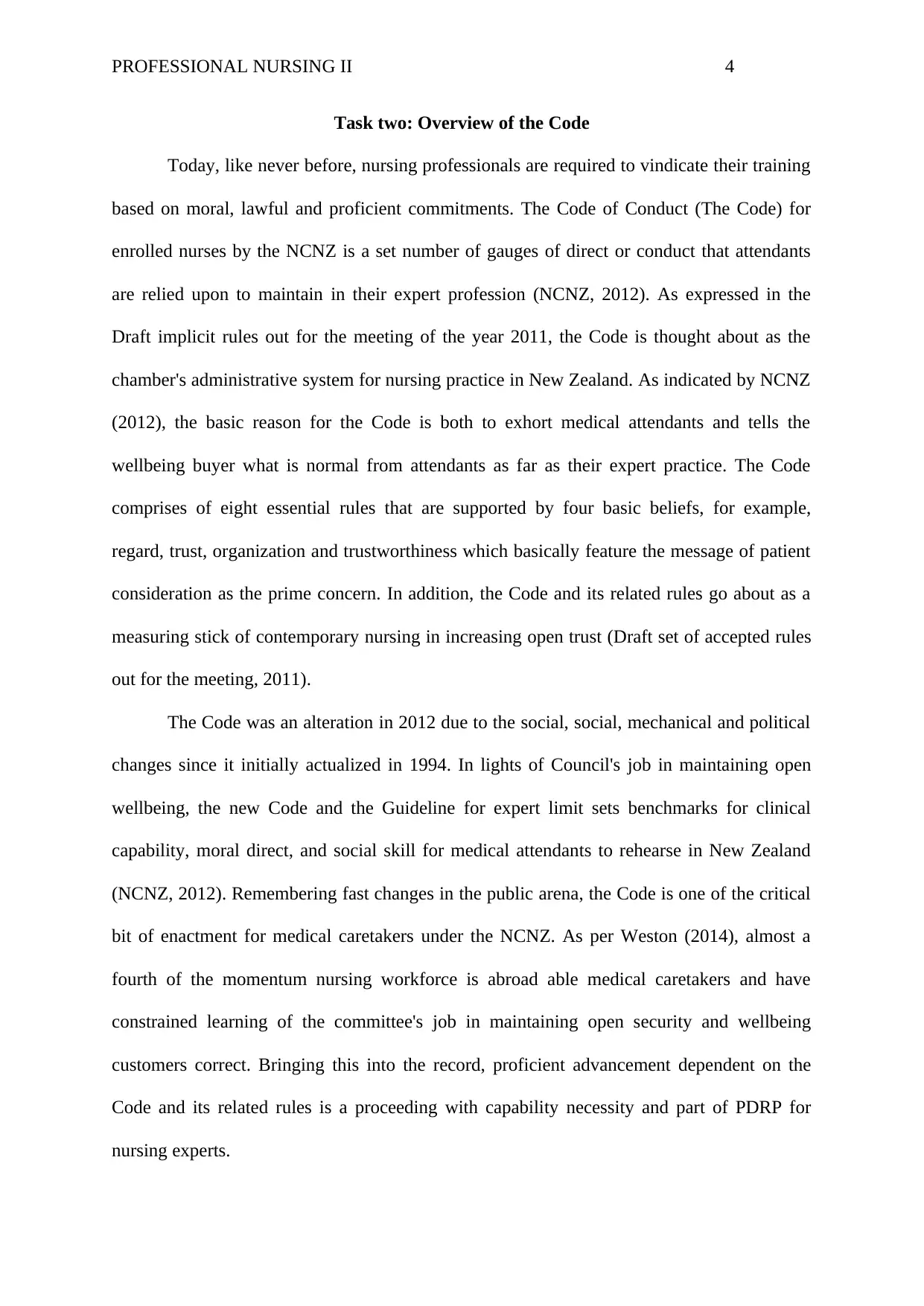
PROFESSIONAL NURSING II 4
Task two: Overview of the Code
Today, like never before, nursing professionals are required to vindicate their training
based on moral, lawful and proficient commitments. The Code of Conduct (The Code) for
enrolled nurses by the NCNZ is a set number of gauges of direct or conduct that attendants
are relied upon to maintain in their expert profession (NCNZ, 2012). As expressed in the
Draft implicit rules out for the meeting of the year 2011, the Code is thought about as the
chamber's administrative system for nursing practice in New Zealand. As indicated by NCNZ
(2012), the basic reason for the Code is both to exhort medical attendants and tells the
wellbeing buyer what is normal from attendants as far as their expert practice. The Code
comprises of eight essential rules that are supported by four basic beliefs, for example,
regard, trust, organization and trustworthiness which basically feature the message of patient
consideration as the prime concern. In addition, the Code and its related rules go about as a
measuring stick of contemporary nursing in increasing open trust (Draft set of accepted rules
out for the meeting, 2011).
The Code was an alteration in 2012 due to the social, social, mechanical and political
changes since it initially actualized in 1994. In lights of Council's job in maintaining open
wellbeing, the new Code and the Guideline for expert limit sets benchmarks for clinical
capability, moral direct, and social skill for medical attendants to rehearse in New Zealand
(NCNZ, 2012). Remembering fast changes in the public arena, the Code is one of the critical
bit of enactment for medical caretakers under the NCNZ. As per Weston (2014), almost a
fourth of the momentum nursing workforce is abroad able medical caretakers and have
constrained learning of the committee's job in maintaining open security and wellbeing
customers correct. Bringing this into the record, proficient advancement dependent on the
Code and its related rules is a proceeding with capability necessity and part of PDRP for
nursing experts.
Task two: Overview of the Code
Today, like never before, nursing professionals are required to vindicate their training
based on moral, lawful and proficient commitments. The Code of Conduct (The Code) for
enrolled nurses by the NCNZ is a set number of gauges of direct or conduct that attendants
are relied upon to maintain in their expert profession (NCNZ, 2012). As expressed in the
Draft implicit rules out for the meeting of the year 2011, the Code is thought about as the
chamber's administrative system for nursing practice in New Zealand. As indicated by NCNZ
(2012), the basic reason for the Code is both to exhort medical attendants and tells the
wellbeing buyer what is normal from attendants as far as their expert practice. The Code
comprises of eight essential rules that are supported by four basic beliefs, for example,
regard, trust, organization and trustworthiness which basically feature the message of patient
consideration as the prime concern. In addition, the Code and its related rules go about as a
measuring stick of contemporary nursing in increasing open trust (Draft set of accepted rules
out for the meeting, 2011).
The Code was an alteration in 2012 due to the social, social, mechanical and political
changes since it initially actualized in 1994. In lights of Council's job in maintaining open
wellbeing, the new Code and the Guideline for expert limit sets benchmarks for clinical
capability, moral direct, and social skill for medical attendants to rehearse in New Zealand
(NCNZ, 2012). Remembering fast changes in the public arena, the Code is one of the critical
bit of enactment for medical caretakers under the NCNZ. As per Weston (2014), almost a
fourth of the momentum nursing workforce is abroad able medical caretakers and have
constrained learning of the committee's job in maintaining open security and wellbeing
customers correct. Bringing this into the record, proficient advancement dependent on the
Code and its related rules is a proceeding with capability necessity and part of PDRP for
nursing experts.
Paraphrase This Document
Need a fresh take? Get an instant paraphrase of this document with our AI Paraphraser
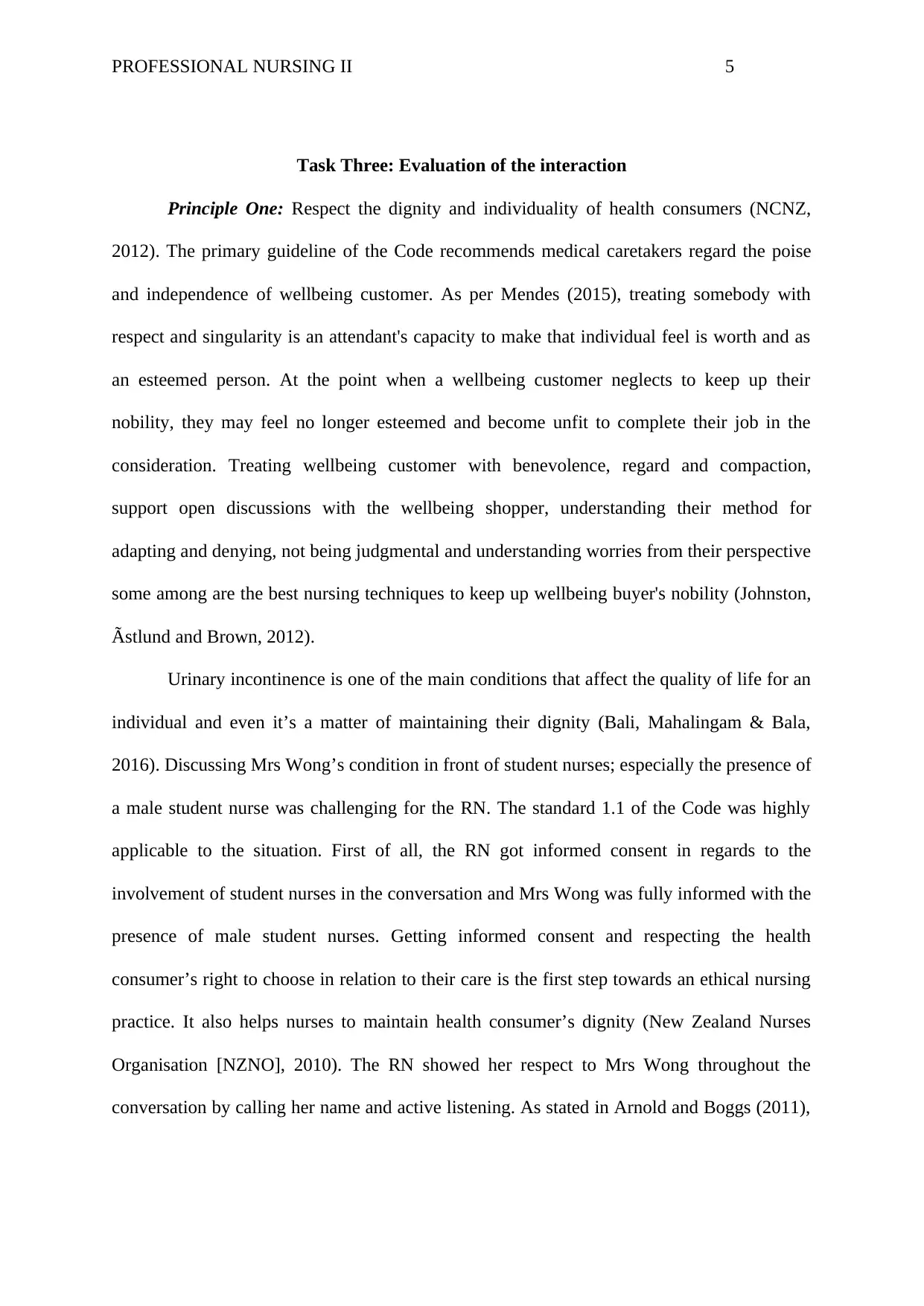
PROFESSIONAL NURSING II 5
Task Three: Evaluation of the interaction
Principle One: Respect the dignity and individuality of health consumers (NCNZ,
2012). The primary guideline of the Code recommends medical caretakers regard the poise
and independence of wellbeing customer. As per Mendes (2015), treating somebody with
respect and singularity is an attendant's capacity to make that individual feel is worth and as
an esteemed person. At the point when a wellbeing customer neglects to keep up their
nobility, they may feel no longer esteemed and become unfit to complete their job in the
consideration. Treating wellbeing customer with benevolence, regard and compaction,
support open discussions with the wellbeing shopper, understanding their method for
adapting and denying, not being judgmental and understanding worries from their perspective
some among are the best nursing techniques to keep up wellbeing buyer's nobility (Johnston,
Ãstlund and Brown, 2012).
Urinary incontinence is one of the main conditions that affect the quality of life for an
individual and even it’s a matter of maintaining their dignity (Bali, Mahalingam & Bala,
2016). Discussing Mrs Wong’s condition in front of student nurses; especially the presence of
a male student nurse was challenging for the RN. The standard 1.1 of the Code was highly
applicable to the situation. First of all, the RN got informed consent in regards to the
involvement of student nurses in the conversation and Mrs Wong was fully informed with the
presence of male student nurses. Getting informed consent and respecting the health
consumer’s right to choose in relation to their care is the first step towards an ethical nursing
practice. It also helps nurses to maintain health consumer’s dignity (New Zealand Nurses
Organisation [NZNO], 2010). The RN showed her respect to Mrs Wong throughout the
conversation by calling her name and active listening. As stated in Arnold and Boggs (2011),
Task Three: Evaluation of the interaction
Principle One: Respect the dignity and individuality of health consumers (NCNZ,
2012). The primary guideline of the Code recommends medical caretakers regard the poise
and independence of wellbeing customer. As per Mendes (2015), treating somebody with
respect and singularity is an attendant's capacity to make that individual feel is worth and as
an esteemed person. At the point when a wellbeing customer neglects to keep up their
nobility, they may feel no longer esteemed and become unfit to complete their job in the
consideration. Treating wellbeing customer with benevolence, regard and compaction,
support open discussions with the wellbeing shopper, understanding their method for
adapting and denying, not being judgmental and understanding worries from their perspective
some among are the best nursing techniques to keep up wellbeing buyer's nobility (Johnston,
Ãstlund and Brown, 2012).
Urinary incontinence is one of the main conditions that affect the quality of life for an
individual and even it’s a matter of maintaining their dignity (Bali, Mahalingam & Bala,
2016). Discussing Mrs Wong’s condition in front of student nurses; especially the presence of
a male student nurse was challenging for the RN. The standard 1.1 of the Code was highly
applicable to the situation. First of all, the RN got informed consent in regards to the
involvement of student nurses in the conversation and Mrs Wong was fully informed with the
presence of male student nurses. Getting informed consent and respecting the health
consumer’s right to choose in relation to their care is the first step towards an ethical nursing
practice. It also helps nurses to maintain health consumer’s dignity (New Zealand Nurses
Organisation [NZNO], 2010). The RN showed her respect to Mrs Wong throughout the
conversation by calling her name and active listening. As stated in Arnold and Boggs (2011),
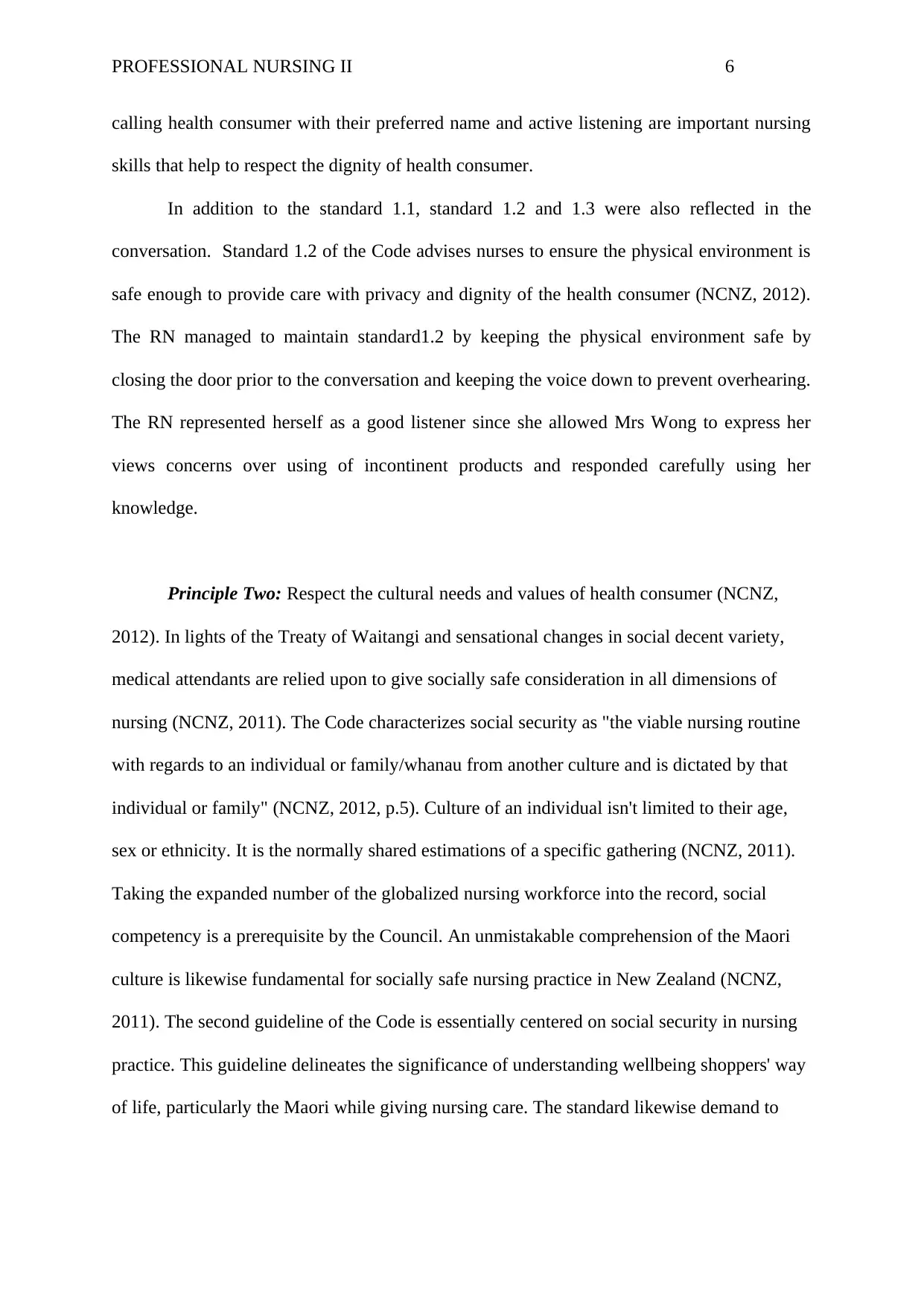
PROFESSIONAL NURSING II 6
calling health consumer with their preferred name and active listening are important nursing
skills that help to respect the dignity of health consumer.
In addition to the standard 1.1, standard 1.2 and 1.3 were also reflected in the
conversation. Standard 1.2 of the Code advises nurses to ensure the physical environment is
safe enough to provide care with privacy and dignity of the health consumer (NCNZ, 2012).
The RN managed to maintain standard1.2 by keeping the physical environment safe by
closing the door prior to the conversation and keeping the voice down to prevent overhearing.
The RN represented herself as a good listener since she allowed Mrs Wong to express her
views concerns over using of incontinent products and responded carefully using her
knowledge.
Principle Two: Respect the cultural needs and values of health consumer (NCNZ,
2012). In lights of the Treaty of Waitangi and sensational changes in social decent variety,
medical attendants are relied upon to give socially safe consideration in all dimensions of
nursing (NCNZ, 2011). The Code characterizes social security as "the viable nursing routine
with regards to an individual or family/whanau from another culture and is dictated by that
individual or family" (NCNZ, 2012, p.5). Culture of an individual isn't limited to their age,
sex or ethnicity. It is the normally shared estimations of a specific gathering (NCNZ, 2011).
Taking the expanded number of the globalized nursing workforce into the record, social
competency is a prerequisite by the Council. An unmistakable comprehension of the Maori
culture is likewise fundamental for socially safe nursing practice in New Zealand (NCNZ,
2011). The second guideline of the Code is essentially centered on social security in nursing
practice. This guideline delineates the significance of understanding wellbeing shoppers' way
of life, particularly the Maori while giving nursing care. The standard likewise demand to
calling health consumer with their preferred name and active listening are important nursing
skills that help to respect the dignity of health consumer.
In addition to the standard 1.1, standard 1.2 and 1.3 were also reflected in the
conversation. Standard 1.2 of the Code advises nurses to ensure the physical environment is
safe enough to provide care with privacy and dignity of the health consumer (NCNZ, 2012).
The RN managed to maintain standard1.2 by keeping the physical environment safe by
closing the door prior to the conversation and keeping the voice down to prevent overhearing.
The RN represented herself as a good listener since she allowed Mrs Wong to express her
views concerns over using of incontinent products and responded carefully using her
knowledge.
Principle Two: Respect the cultural needs and values of health consumer (NCNZ,
2012). In lights of the Treaty of Waitangi and sensational changes in social decent variety,
medical attendants are relied upon to give socially safe consideration in all dimensions of
nursing (NCNZ, 2011). The Code characterizes social security as "the viable nursing routine
with regards to an individual or family/whanau from another culture and is dictated by that
individual or family" (NCNZ, 2012, p.5). Culture of an individual isn't limited to their age,
sex or ethnicity. It is the normally shared estimations of a specific gathering (NCNZ, 2011).
Taking the expanded number of the globalized nursing workforce into the record, social
competency is a prerequisite by the Council. An unmistakable comprehension of the Maori
culture is likewise fundamental for socially safe nursing practice in New Zealand (NCNZ,
2011). The second guideline of the Code is essentially centered on social security in nursing
practice. This guideline delineates the significance of understanding wellbeing shoppers' way
of life, particularly the Maori while giving nursing care. The standard likewise demand to
⊘ This is a preview!⊘
Do you want full access?
Subscribe today to unlock all pages.

Trusted by 1+ million students worldwide
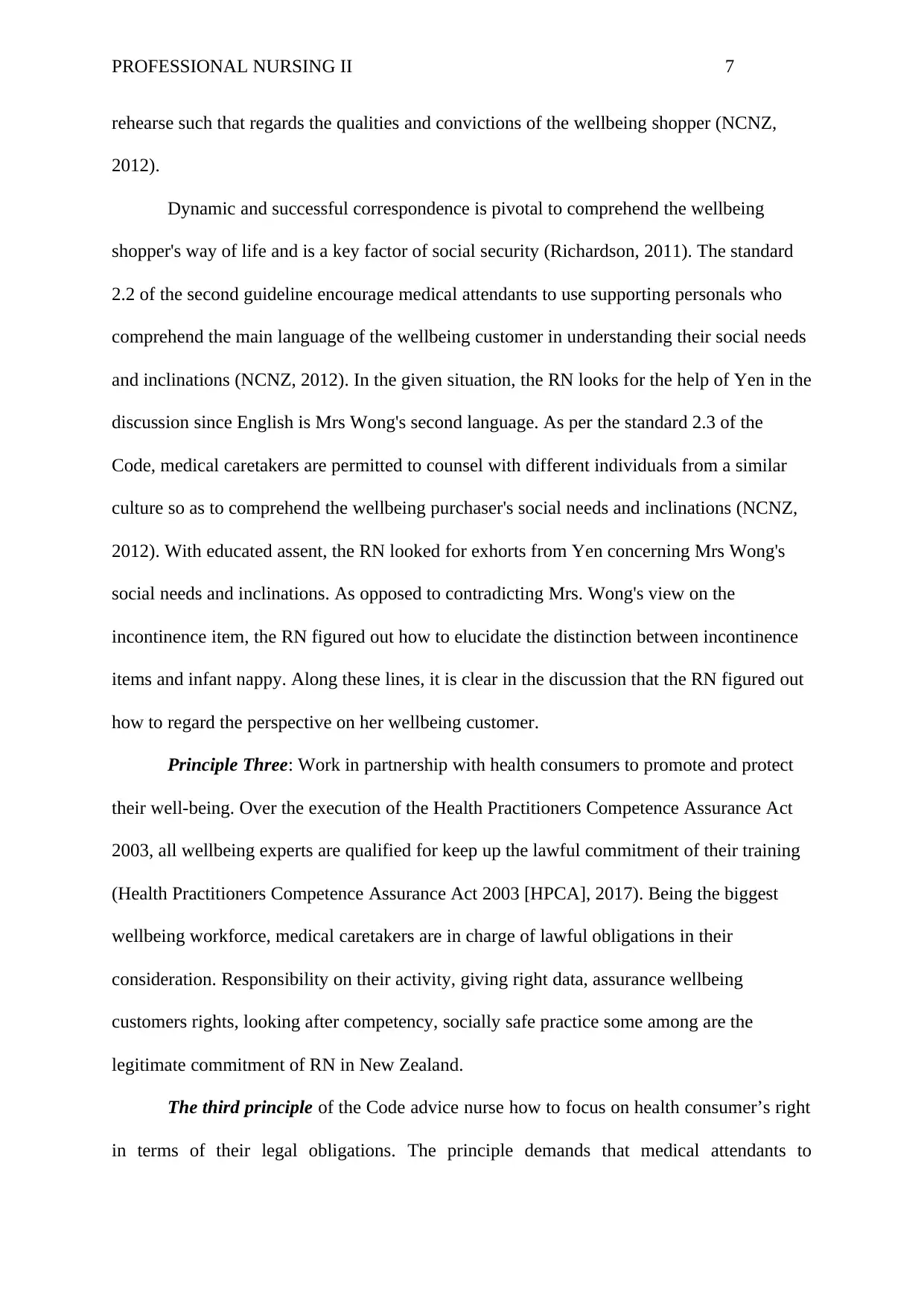
PROFESSIONAL NURSING II 7
rehearse such that regards the qualities and convictions of the wellbeing shopper (NCNZ,
2012).
Dynamic and successful correspondence is pivotal to comprehend the wellbeing
shopper's way of life and is a key factor of social security (Richardson, 2011). The standard
2.2 of the second guideline encourage medical attendants to use supporting personals who
comprehend the main language of the wellbeing customer in understanding their social needs
and inclinations (NCNZ, 2012). In the given situation, the RN looks for the help of Yen in the
discussion since English is Mrs Wong's second language. As per the standard 2.3 of the
Code, medical caretakers are permitted to counsel with different individuals from a similar
culture so as to comprehend the wellbeing purchaser's social needs and inclinations (NCNZ,
2012). With educated assent, the RN looked for exhorts from Yen concerning Mrs Wong's
social needs and inclinations. As opposed to contradicting Mrs. Wong's view on the
incontinence item, the RN figured out how to elucidate the distinction between incontinence
items and infant nappy. Along these lines, it is clear in the discussion that the RN figured out
how to regard the perspective on her wellbeing customer.
Principle Three: Work in partnership with health consumers to promote and protect
their well-being. Over the execution of the Health Practitioners Competence Assurance Act
2003, all wellbeing experts are qualified for keep up the lawful commitment of their training
(Health Practitioners Competence Assurance Act 2003 [HPCA], 2017). Being the biggest
wellbeing workforce, medical caretakers are in charge of lawful obligations in their
consideration. Responsibility on their activity, giving right data, assurance wellbeing
customers rights, looking after competency, socially safe practice some among are the
legitimate commitment of RN in New Zealand.
The third principle of the Code advice nurse how to focus on health consumer’s right
in terms of their legal obligations. The principle demands that medical attendants to
rehearse such that regards the qualities and convictions of the wellbeing shopper (NCNZ,
2012).
Dynamic and successful correspondence is pivotal to comprehend the wellbeing
shopper's way of life and is a key factor of social security (Richardson, 2011). The standard
2.2 of the second guideline encourage medical attendants to use supporting personals who
comprehend the main language of the wellbeing customer in understanding their social needs
and inclinations (NCNZ, 2012). In the given situation, the RN looks for the help of Yen in the
discussion since English is Mrs Wong's second language. As per the standard 2.3 of the
Code, medical caretakers are permitted to counsel with different individuals from a similar
culture so as to comprehend the wellbeing purchaser's social needs and inclinations (NCNZ,
2012). With educated assent, the RN looked for exhorts from Yen concerning Mrs Wong's
social needs and inclinations. As opposed to contradicting Mrs. Wong's view on the
incontinence item, the RN figured out how to elucidate the distinction between incontinence
items and infant nappy. Along these lines, it is clear in the discussion that the RN figured out
how to regard the perspective on her wellbeing customer.
Principle Three: Work in partnership with health consumers to promote and protect
their well-being. Over the execution of the Health Practitioners Competence Assurance Act
2003, all wellbeing experts are qualified for keep up the lawful commitment of their training
(Health Practitioners Competence Assurance Act 2003 [HPCA], 2017). Being the biggest
wellbeing workforce, medical caretakers are in charge of lawful obligations in their
consideration. Responsibility on their activity, giving right data, assurance wellbeing
customers rights, looking after competency, socially safe practice some among are the
legitimate commitment of RN in New Zealand.
The third principle of the Code advice nurse how to focus on health consumer’s right
in terms of their legal obligations. The principle demands that medical attendants to
Paraphrase This Document
Need a fresh take? Get an instant paraphrase of this document with our AI Paraphraser
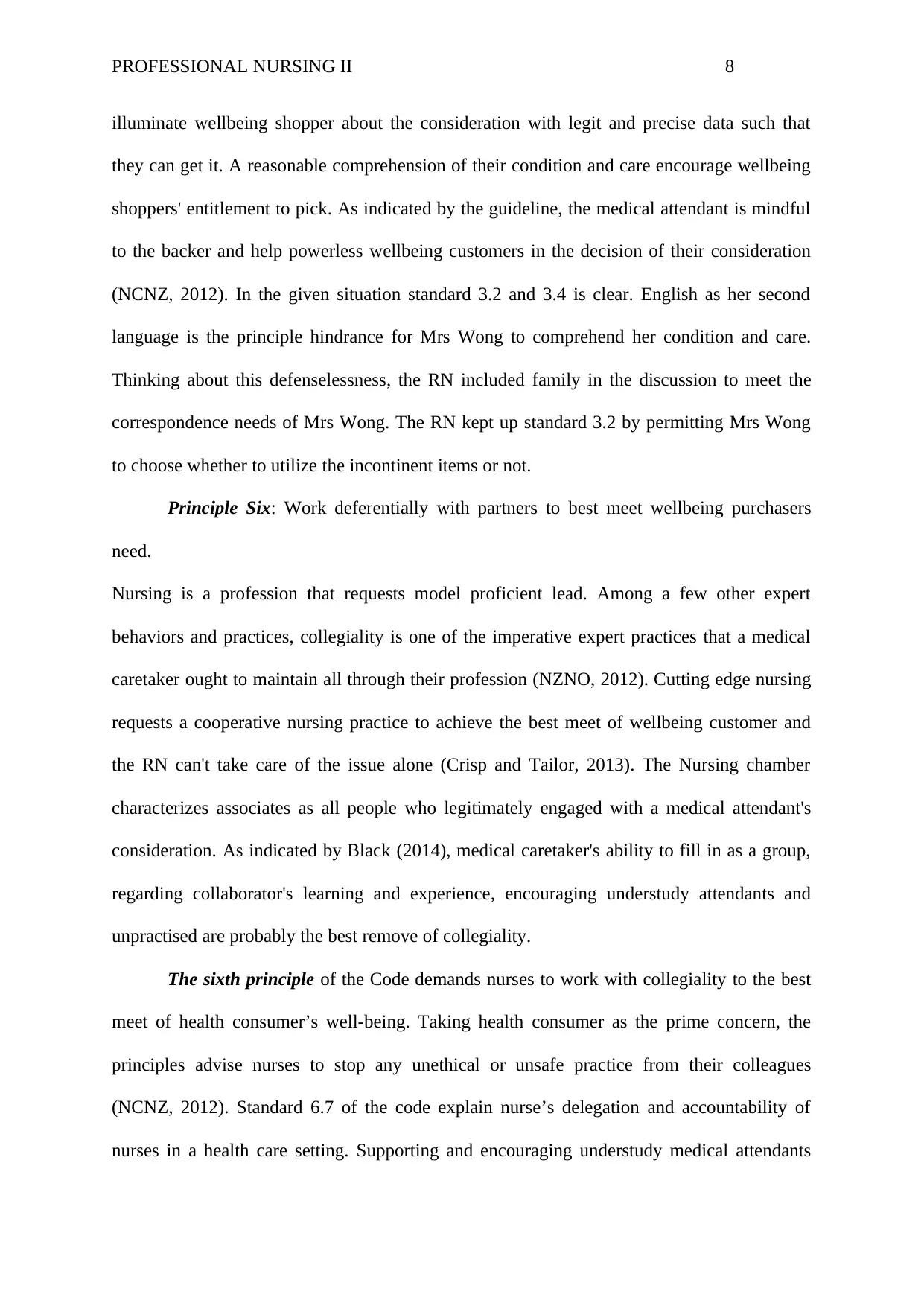
PROFESSIONAL NURSING II 8
illuminate wellbeing shopper about the consideration with legit and precise data such that
they can get it. A reasonable comprehension of their condition and care encourage wellbeing
shoppers' entitlement to pick. As indicated by the guideline, the medical attendant is mindful
to the backer and help powerless wellbeing customers in the decision of their consideration
(NCNZ, 2012). In the given situation standard 3.2 and 3.4 is clear. English as her second
language is the principle hindrance for Mrs Wong to comprehend her condition and care.
Thinking about this defenselessness, the RN included family in the discussion to meet the
correspondence needs of Mrs Wong. The RN kept up standard 3.2 by permitting Mrs Wong
to choose whether to utilize the incontinent items or not.
Principle Six: Work deferentially with partners to best meet wellbeing purchasers
need.
Nursing is a profession that requests model proficient lead. Among a few other expert
behaviors and practices, collegiality is one of the imperative expert practices that a medical
caretaker ought to maintain all through their profession (NZNO, 2012). Cutting edge nursing
requests a cooperative nursing practice to achieve the best meet of wellbeing customer and
the RN can't take care of the issue alone (Crisp and Tailor, 2013). The Nursing chamber
characterizes associates as all people who legitimately engaged with a medical attendant's
consideration. As indicated by Black (2014), medical caretaker's ability to fill in as a group,
regarding collaborator's learning and experience, encouraging understudy attendants and
unpractised are probably the best remove of collegiality.
The sixth principle of the Code demands nurses to work with collegiality to the best
meet of health consumer’s well-being. Taking health consumer as the prime concern, the
principles advise nurses to stop any unethical or unsafe practice from their colleagues
(NCNZ, 2012). Standard 6.7 of the code explain nurse’s delegation and accountability of
nurses in a health care setting. Supporting and encouraging understudy medical attendants
illuminate wellbeing shopper about the consideration with legit and precise data such that
they can get it. A reasonable comprehension of their condition and care encourage wellbeing
shoppers' entitlement to pick. As indicated by the guideline, the medical attendant is mindful
to the backer and help powerless wellbeing customers in the decision of their consideration
(NCNZ, 2012). In the given situation standard 3.2 and 3.4 is clear. English as her second
language is the principle hindrance for Mrs Wong to comprehend her condition and care.
Thinking about this defenselessness, the RN included family in the discussion to meet the
correspondence needs of Mrs Wong. The RN kept up standard 3.2 by permitting Mrs Wong
to choose whether to utilize the incontinent items or not.
Principle Six: Work deferentially with partners to best meet wellbeing purchasers
need.
Nursing is a profession that requests model proficient lead. Among a few other expert
behaviors and practices, collegiality is one of the imperative expert practices that a medical
caretaker ought to maintain all through their profession (NZNO, 2012). Cutting edge nursing
requests a cooperative nursing practice to achieve the best meet of wellbeing customer and
the RN can't take care of the issue alone (Crisp and Tailor, 2013). The Nursing chamber
characterizes associates as all people who legitimately engaged with a medical attendant's
consideration. As indicated by Black (2014), medical caretaker's ability to fill in as a group,
regarding collaborator's learning and experience, encouraging understudy attendants and
unpractised are probably the best remove of collegiality.
The sixth principle of the Code demands nurses to work with collegiality to the best
meet of health consumer’s well-being. Taking health consumer as the prime concern, the
principles advise nurses to stop any unethical or unsafe practice from their colleagues
(NCNZ, 2012). Standard 6.7 of the code explain nurse’s delegation and accountability of
nurses in a health care setting. Supporting and encouraging understudy medical attendants
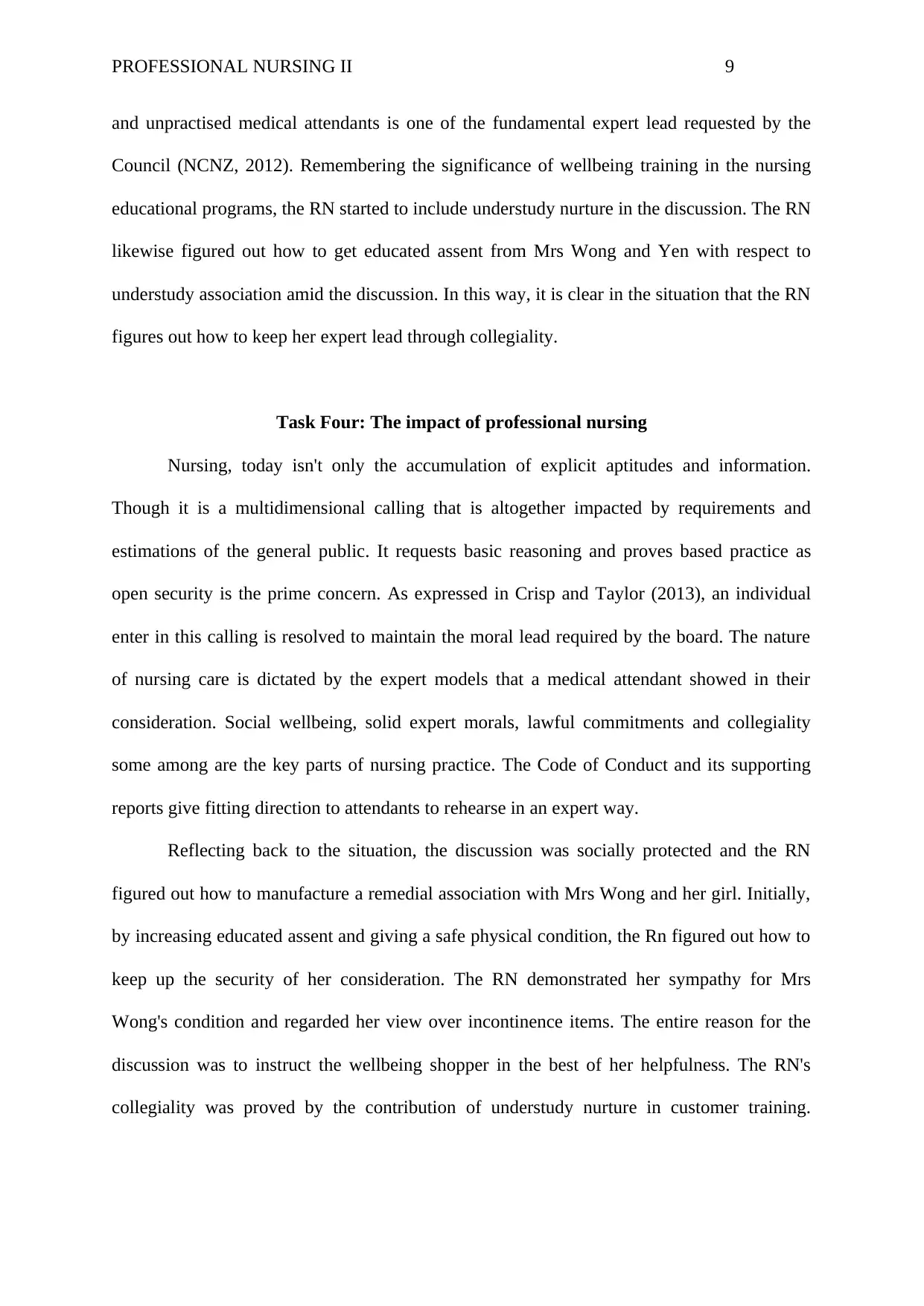
PROFESSIONAL NURSING II 9
and unpractised medical attendants is one of the fundamental expert lead requested by the
Council (NCNZ, 2012). Remembering the significance of wellbeing training in the nursing
educational programs, the RN started to include understudy nurture in the discussion. The RN
likewise figured out how to get educated assent from Mrs Wong and Yen with respect to
understudy association amid the discussion. In this way, it is clear in the situation that the RN
figures out how to keep her expert lead through collegiality.
Task Four: The impact of professional nursing
Nursing, today isn't only the accumulation of explicit aptitudes and information.
Though it is a multidimensional calling that is altogether impacted by requirements and
estimations of the general public. It requests basic reasoning and proves based practice as
open security is the prime concern. As expressed in Crisp and Taylor (2013), an individual
enter in this calling is resolved to maintain the moral lead required by the board. The nature
of nursing care is dictated by the expert models that a medical attendant showed in their
consideration. Social wellbeing, solid expert morals, lawful commitments and collegiality
some among are the key parts of nursing practice. The Code of Conduct and its supporting
reports give fitting direction to attendants to rehearse in an expert way.
Reflecting back to the situation, the discussion was socially protected and the RN
figured out how to manufacture a remedial association with Mrs Wong and her girl. Initially,
by increasing educated assent and giving a safe physical condition, the Rn figured out how to
keep up the security of her consideration. The RN demonstrated her sympathy for Mrs
Wong's condition and regarded her view over incontinence items. The entire reason for the
discussion was to instruct the wellbeing shopper in the best of her helpfulness. The RN's
collegiality was proved by the contribution of understudy nurture in customer training.
and unpractised medical attendants is one of the fundamental expert lead requested by the
Council (NCNZ, 2012). Remembering the significance of wellbeing training in the nursing
educational programs, the RN started to include understudy nurture in the discussion. The RN
likewise figured out how to get educated assent from Mrs Wong and Yen with respect to
understudy association amid the discussion. In this way, it is clear in the situation that the RN
figures out how to keep her expert lead through collegiality.
Task Four: The impact of professional nursing
Nursing, today isn't only the accumulation of explicit aptitudes and information.
Though it is a multidimensional calling that is altogether impacted by requirements and
estimations of the general public. It requests basic reasoning and proves based practice as
open security is the prime concern. As expressed in Crisp and Taylor (2013), an individual
enter in this calling is resolved to maintain the moral lead required by the board. The nature
of nursing care is dictated by the expert models that a medical attendant showed in their
consideration. Social wellbeing, solid expert morals, lawful commitments and collegiality
some among are the key parts of nursing practice. The Code of Conduct and its supporting
reports give fitting direction to attendants to rehearse in an expert way.
Reflecting back to the situation, the discussion was socially protected and the RN
figured out how to manufacture a remedial association with Mrs Wong and her girl. Initially,
by increasing educated assent and giving a safe physical condition, the Rn figured out how to
keep up the security of her consideration. The RN demonstrated her sympathy for Mrs
Wong's condition and regarded her view over incontinence items. The entire reason for the
discussion was to instruct the wellbeing shopper in the best of her helpfulness. The RN's
collegiality was proved by the contribution of understudy nurture in customer training.
⊘ This is a preview!⊘
Do you want full access?
Subscribe today to unlock all pages.

Trusted by 1+ million students worldwide
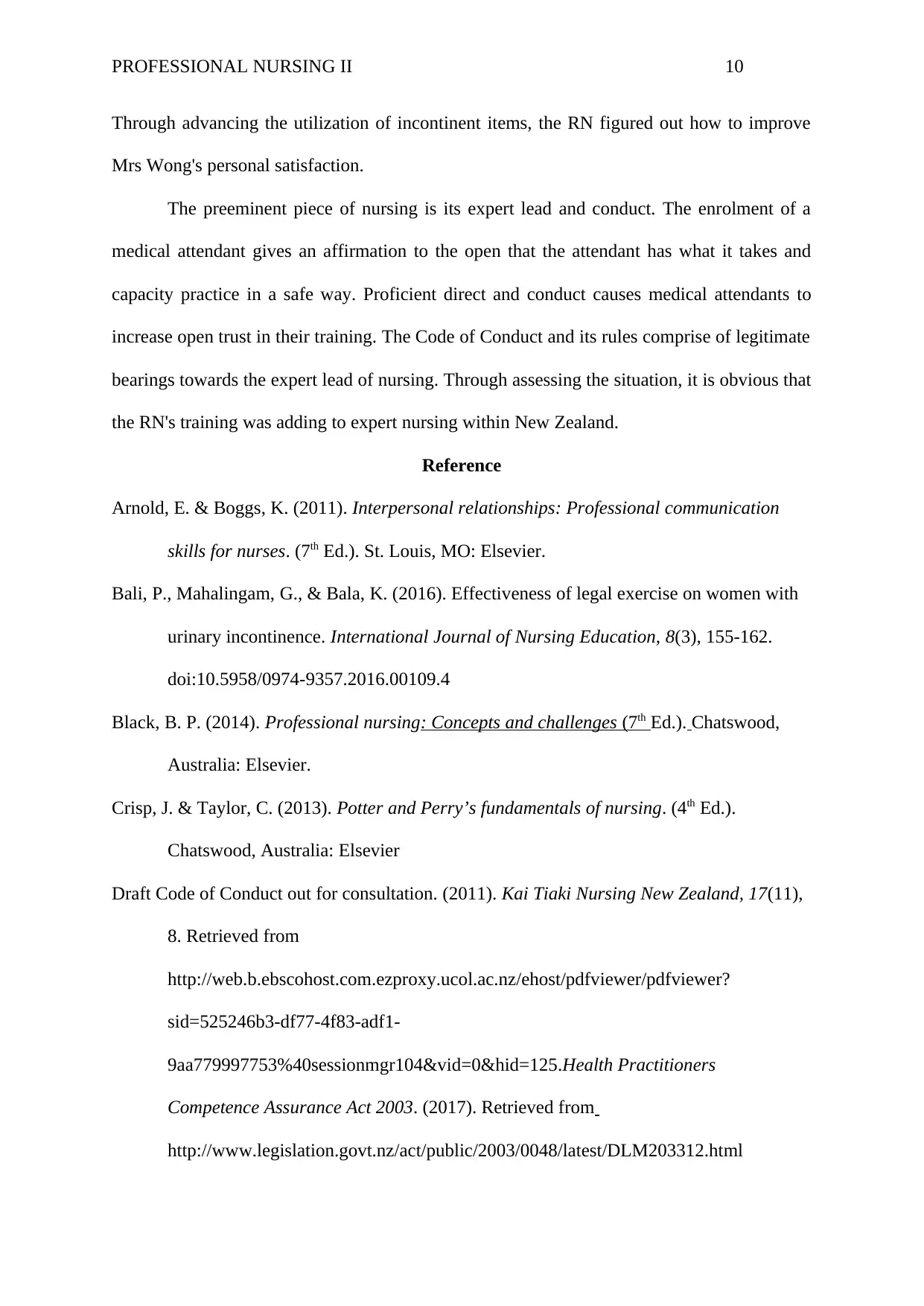
PROFESSIONAL NURSING II 10
Through advancing the utilization of incontinent items, the RN figured out how to improve
Mrs Wong's personal satisfaction.
The preeminent piece of nursing is its expert lead and conduct. The enrolment of a
medical attendant gives an affirmation to the open that the attendant has what it takes and
capacity practice in a safe way. Proficient direct and conduct causes medical attendants to
increase open trust in their training. The Code of Conduct and its rules comprise of legitimate
bearings towards the expert lead of nursing. Through assessing the situation, it is obvious that
the RN's training was adding to expert nursing within New Zealand.
Reference
Arnold, E. & Boggs, K. (2011). Interpersonal relationships: Professional communication
skills for nurses. (7th Ed.). St. Louis, MO: Elsevier.
Bali, P., Mahalingam, G., & Bala, K. (2016). Effectiveness of legal exercise on women with
urinary incontinence. International Journal of Nursing Education, 8(3), 155-162.
doi:10.5958/0974-9357.2016.00109.4
Black, B. P. (2014). Professional nursing: Concepts and challenges (7th Ed.). Chatswood,
Australia: Elsevier.
Crisp, J. & Taylor, C. (2013). Potter and Perry’s fundamentals of nursing. (4th Ed.).
Chatswood, Australia: Elsevier
Draft Code of Conduct out for consultation. (2011). Kai Tiaki Nursing New Zealand, 17(11),
8. Retrieved from
http://web.b.ebscohost.com.ezproxy.ucol.ac.nz/ehost/pdfviewer/pdfviewer?
sid=525246b3-df77-4f83-adf1-
9aa779997753%40sessionmgr104&vid=0&hid=125.Health Practitioners
Competence Assurance Act 2003. (2017). Retrieved from
http://www.legislation.govt.nz/act/public/2003/0048/latest/DLM203312.html
Through advancing the utilization of incontinent items, the RN figured out how to improve
Mrs Wong's personal satisfaction.
The preeminent piece of nursing is its expert lead and conduct. The enrolment of a
medical attendant gives an affirmation to the open that the attendant has what it takes and
capacity practice in a safe way. Proficient direct and conduct causes medical attendants to
increase open trust in their training. The Code of Conduct and its rules comprise of legitimate
bearings towards the expert lead of nursing. Through assessing the situation, it is obvious that
the RN's training was adding to expert nursing within New Zealand.
Reference
Arnold, E. & Boggs, K. (2011). Interpersonal relationships: Professional communication
skills for nurses. (7th Ed.). St. Louis, MO: Elsevier.
Bali, P., Mahalingam, G., & Bala, K. (2016). Effectiveness of legal exercise on women with
urinary incontinence. International Journal of Nursing Education, 8(3), 155-162.
doi:10.5958/0974-9357.2016.00109.4
Black, B. P. (2014). Professional nursing: Concepts and challenges (7th Ed.). Chatswood,
Australia: Elsevier.
Crisp, J. & Taylor, C. (2013). Potter and Perry’s fundamentals of nursing. (4th Ed.).
Chatswood, Australia: Elsevier
Draft Code of Conduct out for consultation. (2011). Kai Tiaki Nursing New Zealand, 17(11),
8. Retrieved from
http://web.b.ebscohost.com.ezproxy.ucol.ac.nz/ehost/pdfviewer/pdfviewer?
sid=525246b3-df77-4f83-adf1-
9aa779997753%40sessionmgr104&vid=0&hid=125.Health Practitioners
Competence Assurance Act 2003. (2017). Retrieved from
http://www.legislation.govt.nz/act/public/2003/0048/latest/DLM203312.html
Paraphrase This Document
Need a fresh take? Get an instant paraphrase of this document with our AI Paraphraser
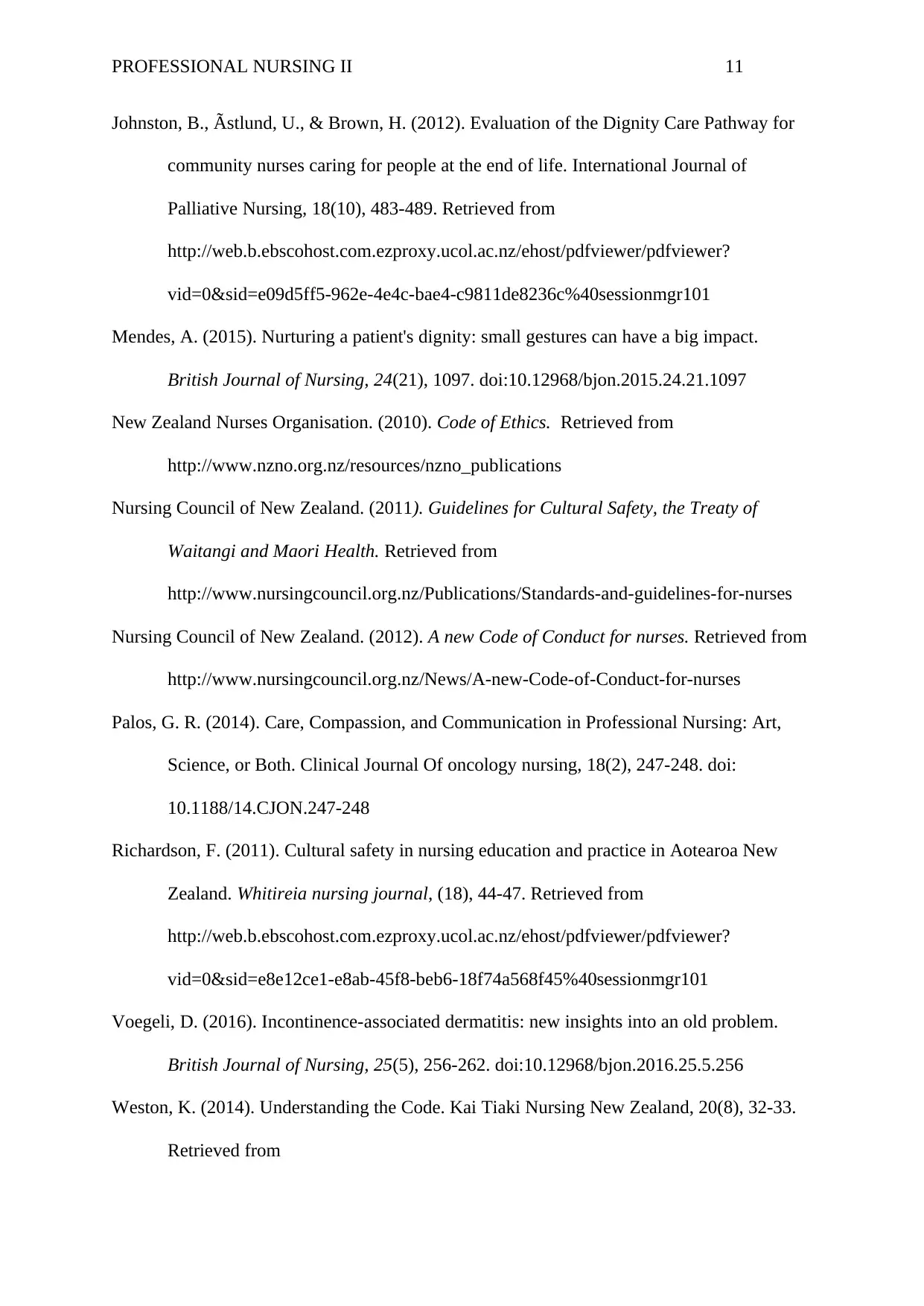
PROFESSIONAL NURSING II 11
Johnston, B., Ãstlund, U., & Brown, H. (2012). Evaluation of the Dignity Care Pathway for
community nurses caring for people at the end of life. International Journal of
Palliative Nursing, 18(10), 483-489. Retrieved from
http://web.b.ebscohost.com.ezproxy.ucol.ac.nz/ehost/pdfviewer/pdfviewer?
vid=0&sid=e09d5ff5-962e-4e4c-bae4-c9811de8236c%40sessionmgr101
Mendes, A. (2015). Nurturing a patient's dignity: small gestures can have a big impact.
British Journal of Nursing, 24(21), 1097. doi:10.12968/bjon.2015.24.21.1097
New Zealand Nurses Organisation. (2010). Code of Ethics. Retrieved from
http://www.nzno.org.nz/resources/nzno_publications
Nursing Council of New Zealand. (2011). Guidelines for Cultural Safety, the Treaty of
Waitangi and Maori Health. Retrieved from
http://www.nursingcouncil.org.nz/Publications/Standards-and-guidelines-for-nurses
Nursing Council of New Zealand. (2012). A new Code of Conduct for nurses. Retrieved from
http://www.nursingcouncil.org.nz/News/A-new-Code-of-Conduct-for-nurses
Palos, G. R. (2014). Care, Compassion, and Communication in Professional Nursing: Art,
Science, or Both. Clinical Journal Of oncology nursing, 18(2), 247-248. doi:
10.1188/14.CJON.247-248
Richardson, F. (2011). Cultural safety in nursing education and practice in Aotearoa New
Zealand. Whitireia nursing journal, (18), 44-47. Retrieved from
http://web.b.ebscohost.com.ezproxy.ucol.ac.nz/ehost/pdfviewer/pdfviewer?
vid=0&sid=e8e12ce1-e8ab-45f8-beb6-18f74a568f45%40sessionmgr101
Voegeli, D. (2016). Incontinence-associated dermatitis: new insights into an old problem.
British Journal of Nursing, 25(5), 256-262. doi:10.12968/bjon.2016.25.5.256
Weston, K. (2014). Understanding the Code. Kai Tiaki Nursing New Zealand, 20(8), 32-33.
Retrieved from
Johnston, B., Ãstlund, U., & Brown, H. (2012). Evaluation of the Dignity Care Pathway for
community nurses caring for people at the end of life. International Journal of
Palliative Nursing, 18(10), 483-489. Retrieved from
http://web.b.ebscohost.com.ezproxy.ucol.ac.nz/ehost/pdfviewer/pdfviewer?
vid=0&sid=e09d5ff5-962e-4e4c-bae4-c9811de8236c%40sessionmgr101
Mendes, A. (2015). Nurturing a patient's dignity: small gestures can have a big impact.
British Journal of Nursing, 24(21), 1097. doi:10.12968/bjon.2015.24.21.1097
New Zealand Nurses Organisation. (2010). Code of Ethics. Retrieved from
http://www.nzno.org.nz/resources/nzno_publications
Nursing Council of New Zealand. (2011). Guidelines for Cultural Safety, the Treaty of
Waitangi and Maori Health. Retrieved from
http://www.nursingcouncil.org.nz/Publications/Standards-and-guidelines-for-nurses
Nursing Council of New Zealand. (2012). A new Code of Conduct for nurses. Retrieved from
http://www.nursingcouncil.org.nz/News/A-new-Code-of-Conduct-for-nurses
Palos, G. R. (2014). Care, Compassion, and Communication in Professional Nursing: Art,
Science, or Both. Clinical Journal Of oncology nursing, 18(2), 247-248. doi:
10.1188/14.CJON.247-248
Richardson, F. (2011). Cultural safety in nursing education and practice in Aotearoa New
Zealand. Whitireia nursing journal, (18), 44-47. Retrieved from
http://web.b.ebscohost.com.ezproxy.ucol.ac.nz/ehost/pdfviewer/pdfviewer?
vid=0&sid=e8e12ce1-e8ab-45f8-beb6-18f74a568f45%40sessionmgr101
Voegeli, D. (2016). Incontinence-associated dermatitis: new insights into an old problem.
British Journal of Nursing, 25(5), 256-262. doi:10.12968/bjon.2016.25.5.256
Weston, K. (2014). Understanding the Code. Kai Tiaki Nursing New Zealand, 20(8), 32-33.
Retrieved from
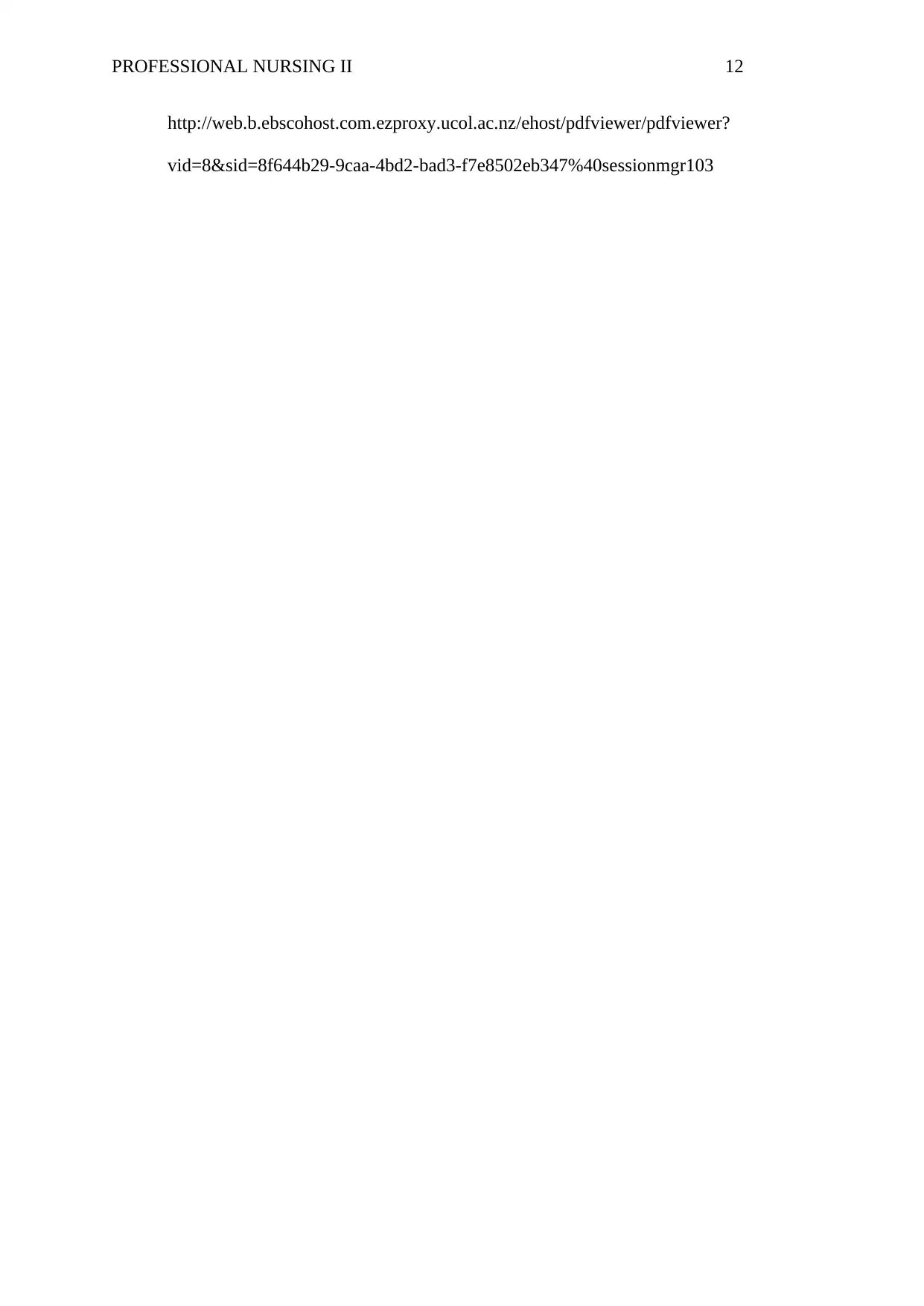
PROFESSIONAL NURSING II 12
http://web.b.ebscohost.com.ezproxy.ucol.ac.nz/ehost/pdfviewer/pdfviewer?
vid=8&sid=8f644b29-9caa-4bd2-bad3-f7e8502eb347%40sessionmgr103
http://web.b.ebscohost.com.ezproxy.ucol.ac.nz/ehost/pdfviewer/pdfviewer?
vid=8&sid=8f644b29-9caa-4bd2-bad3-f7e8502eb347%40sessionmgr103
⊘ This is a preview!⊘
Do you want full access?
Subscribe today to unlock all pages.

Trusted by 1+ million students worldwide
1 out of 12
Your All-in-One AI-Powered Toolkit for Academic Success.
+13062052269
info@desklib.com
Available 24*7 on WhatsApp / Email
![[object Object]](/_next/static/media/star-bottom.7253800d.svg)
Unlock your academic potential
Copyright © 2020–2025 A2Z Services. All Rights Reserved. Developed and managed by ZUCOL.